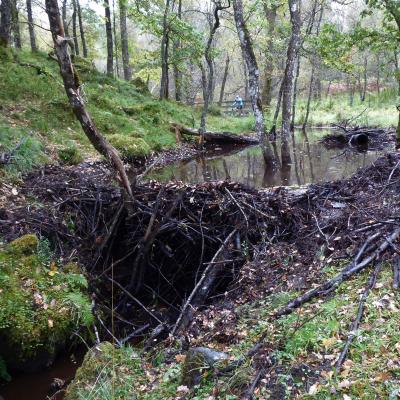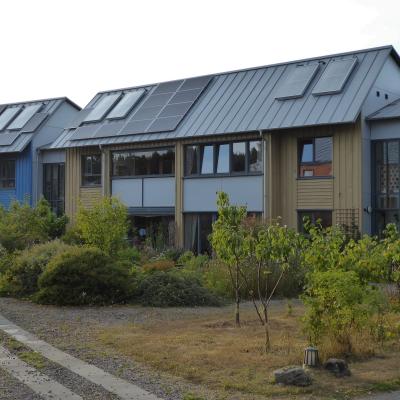Can tourism be green? What is your carbon footprint when travelling? Should I fly?
Looking at the Exodus Adventure travels brochure inspired me to write this blog. As I scanned through the exotic adventures they offer I was drawn to their carbon labels. What do these mean?
Exodus have commissioned consultants to estimate the carbon footprint of the guided tours that they offer. This is expressed as a number of tonnes of carbon dioxide (and other greenhouse gases) emitted per person per day. It includes accommodation, food paid for by Exodus, activities, any in-trip transport and a share of the tour leader’s emissions. It excludes meals paid separately by the participant, and crucially excludes travel to the start and home after the tour. This exclusion is because Exodus offers tours all around the world and they don’t know where each participant lives. However, this is a big omission as I will explore below.
Averages
The average emissions are 34kgCO2e per person per day. This is further split by category of holiday; 20kg/per day for walking, 32kg/per day for family, 51kg/per day for cultural and 83kg/day for wildlife.
This compares to the average carbon emissions of a UK citizen of 16kg per day, or 27kg if you quite correctly include all our consumption related emissions (mainly imported food and goods). This is based on average emissions of 6 tonnes per year or 11 tonnes per year including consumption. Not surprisingly, given the additional travel and activities, most holidays are more carbon intensive than staying at home, even before taking account of any flights.
On average, the total holiday emissions are split between accommodation 29%, cruises 18%, meals 12%, transfers 9%, activities 7%, in-holiday flights 7%, group leader 5%and other 13%.
Note that the total impact of meals will be higher as on some tours very few meals are paid for by Exodus.
Examining the figures more closely I also noticed that tours involving luxury accommodation have a higher carbon footprint than those staying in lodges, and not surprisingly camping is lower still. So, luxury holidays have a high carbon footprint. Don’t be fooled by “eco-lodges”. Whilst the electricity and heating might be green, they often have a high construction footprint and encourage consumption (and wasteful) lifestyles.
Interestingly, Intrepid Travel also publish carbon footprint labels, but they add 15% to their estimated footprints for “contingencies”.
Extremes
Exodus highlight their “low carbon collection”. This includes snowshoeing in Finland (9kg/per day), trekking in Nepal (12kg per day), cycle Namibia (12kg per day) and walking in the Slovenian Alps (14kg/per day).
Not surprisingly walking and cycling holidays have a lower carbon footprint than those involving buses or trains. Finland has a high proportion of renewable electricity and heating provided from biomass. Trekking in Nepal includes living in homestays which I guess have a far lower footprint than purpose-built hotels.
At the other extreme are cruise trips to the Arctic. And here I admire Exodus’s honesty. They advertise one Antarctic cruise at 365kg per day, Svalbard including a flight (485kg per day) and Greenland cruise (340kg per day). These cruises include full board catering, but the critical factor is that cruise ships are a carbon intensive way to travel. Smaller (often described as more sustainable) cruise ships have a larger footprint per person than larger ships.
That’s a pity, I quite fancy seeing icebergs (and penguins).
Flights
Exodus is open about excluding flights from their calculations, yet I think this is rather disingenuous. They do state that a single economy flight from London to Rome would emit around 277kg versus 33kg by train. Interestingly this calculation includes the UK Government’s recommended uplift (x1.7) for extra ‘radiative forcing’ caused by contrails and emitting pollution at altitude.
But let’s look more closely at their “low carbon collection.” Here I adjust the published figures to include a return flight from London (without radiative forcing).
A return flight from London to Lapland will emit 550kg. The total emissions from the 7-day holiday will then be 550+(9x7) = 613kg. Trekking in Nepal for 18 days will emit 1700+(9x18) = 1,862kg. The emissions within Nepal are less than 10% of the total emissions caused by this so called ‘low carbon’ holiday. The emission from flights is even worse if you fly business class or if you include the extra radiative forcing.
Flying is not low carbon and will not be for decades to come.
Length of Trip
Whilst the carbon footprint of a trip increases directly in proportion to the length of the trip, the emissions from your flights are fixed. So, you can decrease your daily emissions by taking a longer holiday.
Indeed, you could theoretically reduce your annual emissions if you flew to Lapland for a very long holiday. You would ‘save’ 7kg for each day there (16kg-9kg) and after 78 days this would offset your flight. Even better if you travelled there by train.
Alternatives
Exodus partner with Byway to help you to organise flight free travel. This could be a good option for those who are not time poor for travel to European destinations.
Intrepid Travel state that they are stopping all scenic flights on their trips, deemed to be an unnecessary, and optional, additional source of emissions.
If you’d like to know more about tourism and the oceans then take a look at this guide"40 Facts and statistics about tourism & ocean sustainability".
Conclusions
Exodus and Intrepid should be congratulated for opening this debate.
There are few surprises:
- Flights dominate your carbon footprint; long-haul is particularly bad;
- Luxury hotels are carbon intensive, followed by guest houses, homestays and camping;
- Eating and drinking have a high carbon footprint, and we often eat to excess on holiday;
- Anything involving boats tends to have a high carbon footprint; and
- Antarctic cruises on small cruise ships, with full catering and a flight from the UK are the highest ‘normal’ holidays advertised.
In terms of recommendations, clearly it would be better not to travel extensively or stay in luxury accommodation. If you must travel, a simple piece of advice is to go on fewer, but longer holidays. Weekend city breaks are hard to justify.
Cracking our addiction to flying is difficult. Individual action can help a little, but guilt led constraint by some individuals will not solve our climate crisis. We really need a systemic solution. Carbon taxes, investment in innovation, a frequent flyer levy, a ban on air mile perks and permanent carbon offsetting of aviation’s emissions.
--------------------------------------------------------------------------------------------------------------------------
Carbon Choices
To get first sight of my new blogs, email me at This email address is being protected from spambots. You need JavaScript enabled to view it. with the header “please subscribe”.
You might also enjoy my book, Carbon Choices, on the common-sense solutions to our climate and nature crises. Available from Amazon or a signed copy direct from me. I am donating one third of profits to rewilding projects.
Please follow me on social media:
LinkedIn, X, Facebook, Instagram and now on Bluesky
Please feel free to share any of my blogs.









